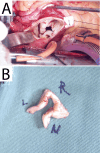Aortic Unicuspid Valve Surgery in a Young Patient: A Case Report
- PMID: 39776732
- PMCID: PMC11704650
- DOI: 10.7759/cureus.75305
Aortic Unicuspid Valve Surgery in a Young Patient: A Case Report
Abstract
The patient was a 33-year-old male. He was noted to have a systolic murmur in the aortic valve region during childhood and underwent balloon valvuloplasty at a pediatric clinic. However, he was not followed up thereafter. Recently, he began experiencing exertional dyspnea and presented to our cardiology department. Detailed examinations, including echocardiography, revealed moderate aortic regurgitation and stenosis, and a unicuspid aortic valve was suspected morphologically. After discussing the findings with the patient, he opted for surgical treatment. The operation was performed under general anesthesia via a median sternotomy. Intraoperative inspection of the aortic valve confirmed a unicuspid morphology, consistent with the preoperative findings. The unicuspid valve was excised and replaced with a mechanical valve (St. Jude Medical (SJM) 25 mm). The surgery was completed without complications, and the postoperative course was uneventful. The patient was discharged home on postoperative day 10. Five years postoperatively, the patient remains asymptomatic and in good condition. Given the rarity of unicuspid aortic valve cases, this report is of significant clinical value.
Keywords: aortic valve replacement; aortic valve stenosis; cardiac arrest; unicuspid valve; young.
Copyright © 2024, Nakajima et al.
Conflict of interest statement
Human subjects: Consent for treatment and open access publication was obtained or waived by all participants in this study. Conflicts of interest: In compliance with the ICMJE uniform disclosure form, all authors declare the following: Payment/services info: All authors have declared that no financial support was received from any organization for the submitted work. Financial relationships: All authors have declared that they have no financial relationships at present or within the previous three years with any organizations that might have an interest in the submitted work. Other relationships: All authors have declared that there are no other relationships or activities that could appear to have influenced the submitted work.
Figures




Similar articles
-
Unicuspid aortic valve replacement with development of complete heart block: a case report.Eur Heart J Case Rep. 2019 Mar 15;3(1):ytz026. doi: 10.1093/ehjcr/ytz026. eCollection 2019 Mar. Eur Heart J Case Rep. 2019. PMID: 31020268 Free PMC article.
-
Congenital aortic stenosis due to unicuspid unicommissural aortic valve: a case report.J Cardiothorac Surg. 2018 Jun 7;13(1):61. doi: 10.1186/s13019-018-0755-0. J Cardiothorac Surg. 2018. PMID: 29880056 Free PMC article.
-
The hidden unicuspid: Recurring aortic stenosis post-valvuloplasty from a unicuspid aortic valve masquerading as bicuspid.J Cardiol Cases. 2023 Jul 29;28(5):213-215. doi: 10.1016/j.jccase.2023.07.005. eCollection 2023 Nov. J Cardiol Cases. 2023. PMID: 38024116 Free PMC article.
-
Accessory mitral valve associated with aortic regurgitation in an elderly patient: report of a case.Surg Today. 2002;32(6):516-8. doi: 10.1007/s005950200088. Surg Today. 2002. PMID: 12107777 Review.
-
Congenital unicuspid aortic valve in adults: Minireview and case series.Ann Pediatr Cardiol. 2024 Jul-Aug;17(4):243-249. doi: 10.4103/apc.apc_153_24. Epub 2024 Nov 15. Ann Pediatr Cardiol. 2024. PMID: 39698435 Free PMC article. Review.
References
Publication types
LinkOut - more resources
Full Text Sources
